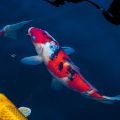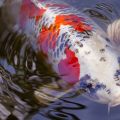ALL YOU NEED TO KNOW ABOUT THE MAJESTIC KOI

The majestic koi fish are a type of carp said to have originated in China, and later bred in Japan to produce the vibrantly coloured fish we are familiar with today. The Japanese name for koi fish is actually Nishikigoi, which means “coloured carp”. While koi fish are largely ornamentally used today, Chinese written records dating over 2000 years back indicate that they were once consumed for food. Bred from black carp by the Japanese in the 1800s, koi fish gained more attention when officially presented at the prestigious Taisho exhibition organised in Tokyo in 1915.\
Constructing A Pond For Koi
It is important to construct a suitable pond to house koi fish. The dimensions of the pond should take into account the size of the fish, as well as the equipment that will be used to maintain them. A pond volume of at least 1 to 3 cubic metres per koi, and a depth between 1.5 metres and 2.5 metres are usually optimal dimensions for the construction of a pond. Sufficient sunlight is required in order to make the colours of the koi stand out vibrantly. However, very harsh sunlight can cause the koi to suffer sunburn. Hence, choosing a location that strikes the right balance between sun and shade is key to displaying the colourful koi in the most striking way possible without harming them.
Quality Of Water
To keep the koi in good health, it is vital to ensure that the water in the pond is not contaminated. This will prevent the fish from contracting diseases caused by poor environmental conditions. A good pond filter can help keep the water clean when chosen based on the size and stock of the pond. Keeping the water at an optimal temperature is also important, with koi fish being most comfortable at warm temperatures. This means that the pond must be frost-proof when winter strikes. Additionally, key water values such as the pH value, ammonia and nitrite levels and carbonate hardness must be regularly monitored. Carbonate hardness levels affect how stable the pH value of the water is, and stable pH values are necessary to keep the pond water healthy for koi fish. Finally, doing partial water changes in the koi pond and removing sludge are important in keeping the pond clean and conducive for the koi to live in.
Koi Fish And Plants
While aquatic plants may seem like a nice addition to the pond or aquarium, it should be noted that Koi fish generally do not coexist well with plants. This is because koi fish tend to ravage aquatic plants for food by digging them or pushing them up, causing significant damage to them. As a result, koi ponds are often devoid of plants, or are only very sparingly planted. If you still want to plant your koi pond, it is recommended that you create distinct shallow regions in the pond, use plant filters or create plant islands. This will increase the likelihood that your koi fish will coexist peacefully with your plants.
Other articles and publications:
- +1 (908) 998-2556
- 205D US-22, Green Brook Township, NJ 08812
- everythingkoi.com







